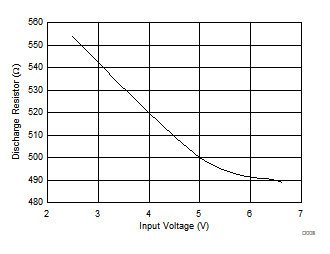SLVSCU5 March 2015 TPS25200-Q1
PRODUCTION DATA.
- 1 Features
- 2 Applications
- 3 Description
- 4 Simplified Schematic
- 5 Revision History
- 6 Pin Configuration and Functions
- 7 Specifications
- 8 Parameter Measurement Information
- 9 Detailed Description
- 10Application and Implementation
- 11Power Supply Recommendations
- 12Layout
- 13Device and Documentation Support
- 14Mechanical, Packaging, and Orderable Information
Package Options
Mechanical Data (Package|Pins)
- DRV|6
Thermal pad, mechanical data (Package|Pins)
- DRV|6
Orderable Information
7 Specifications
7.1 Absolute Maximum Ratings
over operating free-air temperature range, voltage are referenced to GND (unless otherwise noted)(1)| MIN | MAX | UNIT | ||
|---|---|---|---|---|
| Voltage | IN | –0.3 | 20 | V |
| OUT, EN, ILIM, FAULT | –0.3 | 7 | V | |
| From IN to OUT | –7 | 20 | V | |
| Continuous output current, IO | Thermally Limited | |||
| Continuous FAULT output sink current | 25 | mA | ||
| Continuous ILIM output source current | 150 | µA | ||
| Operating junction temperature, TJ | Internally limited | |||
| Storage temperature, Tstg | –65 | 150 | °C | |
(1) Stresses beyond those listed under absolute maximum ratings may cause permanent damage to the device. These are stress ratings only, which do not imply functional operation of the device at these or any other conditions beyond those indicated under recommended operating conditions. Exposure to absolute-maximum-rated conditions for extended periods may affect device reliability.
7.2 ESD Ratings
| VALUE | UNIT | ||||
|---|---|---|---|---|---|
| V(ESD) | Electrostatic discharge | Human body model (HBM), per AEC Q100-002(1) | ±2000 | V | |
| Charged device model (CDM), per AEC Q100-011 | ±750 | ||||
(1) AEC Q100-002 indicates HBM stressing is done in accordance with the ANSI/ESDA/JEDEC JS-001 specification.
7.3 Recommended Operating Conditions
over operating free-air temperature range (unless otherwise noted)| MIN | MAX | UNIT | ||
|---|---|---|---|---|
| VIN | Input voltage of IN | 2.5 | 6.5 | V |
| VEN | Enable pin voltage | 0 | 6.5 | V |
| IFAULT | Continuous FAULT sink current | 0 | 10 | mA |
| IOUT | Continuous output current of OUT | 2.4 | A | |
| RILIM | Current-limit set resistors | 36 | 1100 | kΩ |
| TJ | Operating junction temperature | –40 | 125 | °C |
7.4 Thermal Information
| THERMAL METRIC(1) | DRV (WSON) | UNIT | |
|---|---|---|---|
| 6 PINS | |||
| RθJA | Junction-to-ambient thermal resistance | 66.5 | °C/W |
| RθJC(top) | Junction-to-case (top) thermal resistance | 83.4 | |
| RθJB | Junction-to-board thermal resistance | 36.1 | |
| ψJT | Junction-to-top characterization parameter | 1.6 | |
| ψJB | Junction-to-board characterization parameter | 36.5 | |
| RθJC(bot) | Junction-to-case (bottom) thermal resistance | 7.6 | |
(1) For more information about traditional and new thermal metrics, see the IC Package Thermal Metrics application report, SPRA953.
7.5 Electrical Characteristics
Conditions are –40°C ≤ TJ ≤ 125°C and 2.5 V ≤ VIN ≤ 6.5 V. VEN = VIN, RILIM = 36 kΩ. Positive current into pins. Typical value is at 25°C. All voltages are with respect to ground (unless otherwise noted).| PARAMETER | TEST CONDITIONS | MIN | TYP | MAX | UNIT | ||
|---|---|---|---|---|---|---|---|
| POWER SWITCH | |||||||
| rDS(on) | IN–OUT resistance(1) | 2.5 V ≤ VIN ≤ 5 V, IOUT = 2.4 A |
TJ = 25°C | 67 | 75 | mΩ | |
| –40°C ≤ TJ ≤ 85°C | 67 | 95 | |||||
| –40°C ≤ TJ ≤ 125°C | 67 | 105 | |||||
| ENABLE INPUT EN | |||||||
| EN pin turn on threshold | Input rising | 1.9 | V | ||||
| EN pin turn off threshold | Input falling | 0.6 | V | ||||
| Hysteresis | 330(2) | mV | |||||
| IEN | Leakage current | VEN = 0 V or 5.5 V | –2 | 2 | µA | ||
| DISCHARGE | |||||||
| RDCHG | OUT Discharge Resistance | VOUT = 5 V, VEN = 0 V | 500 | 625 | Ω | ||
| CURRENT LIMIT | |||||||
| IOS | Current-limit, see Figure 12 | RILIM = 36 kΩ | 2530 | 2700 | 2870 | mA | |
| RILIM = 42.2 kΩ | 2140 | 2300 | 2460 | ||||
| RILIM = 56 kΩ | 1620 | 1740 | 1860 | ||||
| RILIM = 80.6 kΩ | 1110 | 1206 | 1300 | ||||
| RILIM = 150 kΩ | 590 | 647 | 710 | ||||
| RILIM = 1100 kΩ | 40 | 83 | 130 | ||||
| OVERVOLTAGE LOCKOUT, IN | |||||||
| V(OVLO) | IN rising OVLO threshold voltage | IN rising | 6.8 | 7.6 | 8.45 | V | |
| Hysteresis | 70(2) | mV | |||||
| VOLTAGE CLAMP, OUT | |||||||
| V(OVC) | OUT clamp voltage threshold | CL = 1 µF, RL = 100 Ω, VIN = 6.5 V | 5.25 | 5.4 | 5.55 | V | |
| SUPPLY CURRENT | |||||||
| IIN(off) | Supply current, low-level output | VEN = 0 V, VIN = 5 V | 1 | 5 | µA | ||
| VEN = 0 or 5 V, VIN = 20 V | 1040 | 1700 | |||||
| IIN(on) | Supply current, high-level output | VIN = 5 V, No load on OUT |
RILIM = 36 kΩ | 147 | 200 | µA | |
| RILIM = 150 kΩ | 120 | 190 | |||||
| IREV | Reverse leakage current | VOUT = 6.5V, VIN = VEN = 0 V, TJ = 25°C, Measure IOUT | 3.2 | 5 | µA | ||
| UNDERVOLTAGE LOCKOUT, IN | |||||||
| VUVLO | IN rising UVLO threshold voltage | IN rising | 2.35 | 2.45 | V | ||
| Hysteresis | 30(2) | mV | |||||
| FAULT FLAG | |||||||
| VOL | Output low voltage, FAULT | IFAULT = 1 mA | 50 | 180 | mV | ||
| Off-state leakage | VFAULT = 6.5 V | 1 | µA | ||||
| THERMAL SHUTDOWN | |||||||
| Thermal shutdown threshold, OTSD2(3) | 155 | °C | |||||
| Thermal shutdown threshold only in current-limit, OTSD1(3) | 135 | ||||||
| Hysteresis | 20(2) | ||||||
(1) Pulse-testing techniques maintain junction temperature close to ambient temperature. Thermal effects must be taken into account separately.
(2) These parameters are provided for reference only and does not constitute part of TI's published device specifications for purposes of TI's product warranty.
(3) For more information on the thermal sensors, OTSD1 and OTSD2, see the Thermal Sense section.
7.6 Switching Characteristics
Conditions are –40°C ≤ TJ ≤ 125°C and 2.5 V ≤ VIN ≤ 6.5 V. VEN = VIN, RILIM = 36 kΩ. Positive current are into pins. Typical value is at 25°C. All voltages are with respect to GND (unless otherwise noted)| PARAMETER | TEST CONDITIONS | MIN | TYP | MAX | UNIT | ||
|---|---|---|---|---|---|---|---|
| POWER SWITCH | |||||||
| tr | OUT voltage rise time | CL = 1 µF, RL = 100 Ω, (see Figure 10) | 2.05 | 3.2 | ms | ||
| tf | OUT voltage fall time | CL = 1 µF, RL = 100 Ω, (see Figure 10) | 0.18 | 0.2 | |||
| ENABLE INPUT EN | |||||||
| ton | Turn-on time | 2.5 V ≤ VIN ≤ 5 V, CL = 1 µF, RL = 100 Ω, (see Figure 10) | 5.12 | 7.3 | ms | ||
| toff | Turn-off time | 2.5 V ≤ VIN ≤ 5 V, CL = 1 µF, RL = 100 Ω, (see Figure 10) | 0.22 | 0.3 | ms | ||
| CURRENT LIMIT | |||||||
| t(IOS) | Short-circuit response time | VIN = 5 V (see Figure 12) | 3.5(1) | µs | |||
| OVERVOLTAGE LOCKOUT, IN | |||||||
| t(OVLO_off_delay) | Turn-off Delay for OVLO | VIN = 5 V to 10 V with 1 V/µs ramp-up rate, VOUT with 100-Ω load | 0.6(1) | µs | |||
| FAULT FLAG | |||||||
| FAULT deglitch | FAULT assertion or deassertion because of overcurrent condition | 5 | 8 | 12 | ms | ||
(1) This parameter is provided for reference only and does not constitute part of TI's published device specifications for purposes of TI's product warranty.
7.7 Typical Characteristics
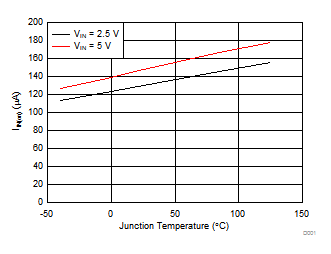
| RILIM = 36 KΩ | ||
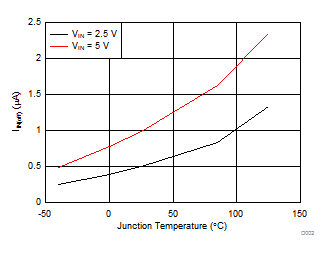
| RILIM = 36 KΩ | ||
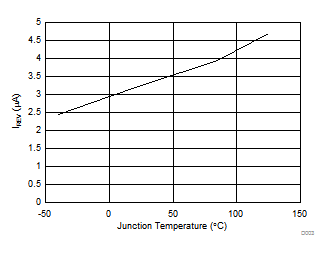
| VEN = VIN = 0 V | VOUT = 6.5 V | |
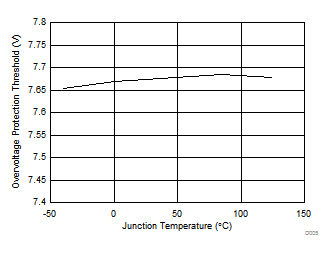
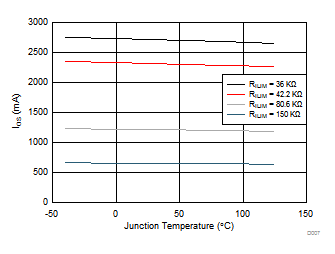
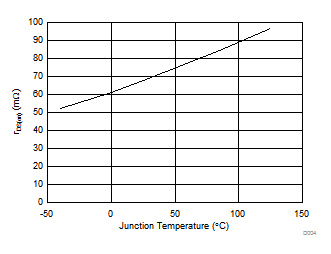
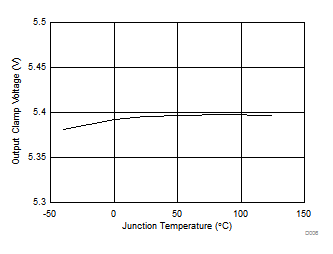
| CL = 1 µF | RL = 100 Ω | VIN = 6.5 V |
